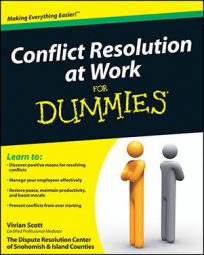Mediating a conflict at work sometimes calls for a private meeting, or caucus, with each individual involved. A private meeting is an excellent opportunity for you to provide a different venue for participants to discuss the conflict on a different level. If you opt to call a caucus, you have some choices to make. You need to decide how to break, whom to meet with first, and what kind of approach to take in the private meeting.
Be sure your employees understand that they aren’t in trouble and that you haven’t given up on the conversation. Explain that you think this is a good opportunity to take a quick break and try something new. Framing this meeting as a positive step in your process helps you manage your employees’ reactions.
Choosing who goes first
No hard and fast rule exists about how to decide whom to meet with first. You know your employees, and you’re the best person to make an assessment about what to do, but here are some determining factors that can help you:
Assess emotions: Decide whether meeting with this person first is an opportunity to help her vent and process, or if letting her relax alone for a few minutes while you meet with the other person is the best use of time.
Assess power: For this conversation to be successful, you want power to be roughly in balance between your participants. An employee who says she doesn’t care, is too overwhelmed to speak, or can’t act in her own best interests may be telling you that she feels disempowered. Meeting first with an employee who feels powerless will probably be more effective than trying to squelch or minimize the other employee’s power.
Assess behavior: Is one of your employees acting out of character? Do you see a typically soft-spoken employee becoming aggressive and demeaning, or an outspoken employee suddenly not making a peep? If so, it’s a sign that something has changed, and you need to check it out.
Whomever you choose to meet with first, be sure to clarify to the other person that he’ll have the same opportunity as the first person.
Allowing parties to open up with added confidentiality
When you send one of your employees out of the room so you can continue your conversation with the other, make a quick statement clarifying that during this time, you’re applying an additional layer of confidentiality. What this means, essentially, is that anything she shares with you during this time, you won’t bring up with the other employee in his private meeting or during an open session.
One of the most vital things you do during a private meeting is create a safe and open environment for your employee. You may likely see this as an opportunity to get down to the bottom of things, but you won’t be able to accomplish that unless your employee trusts that this is a safe place to have that conversation.

